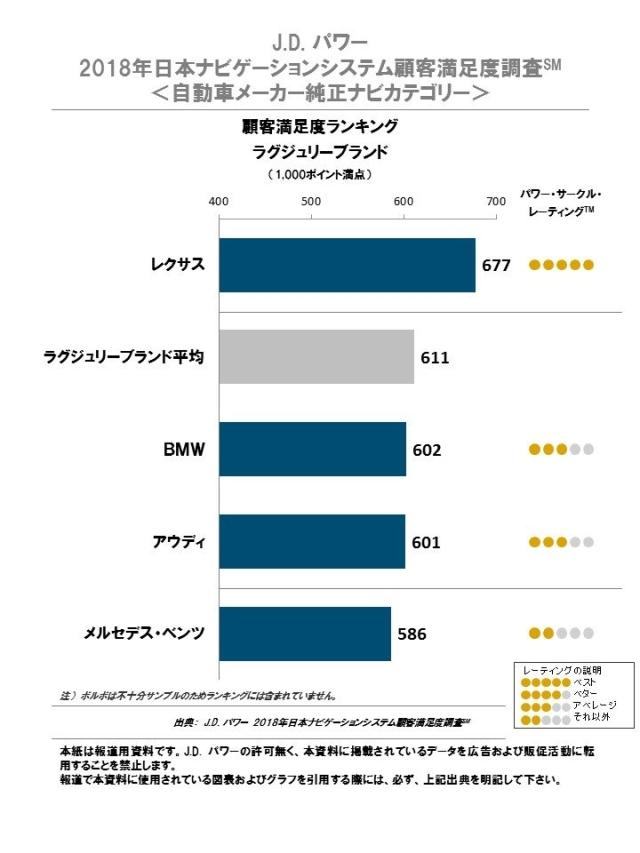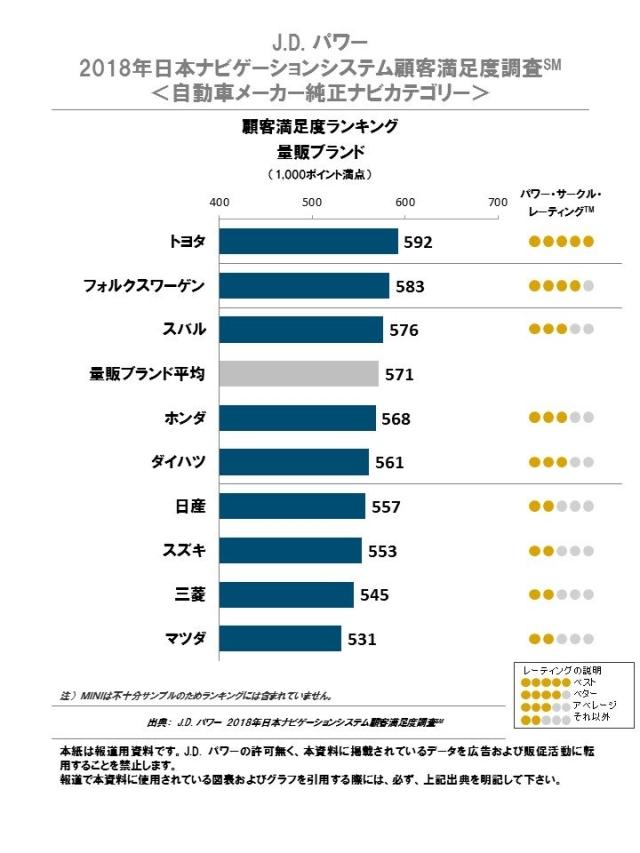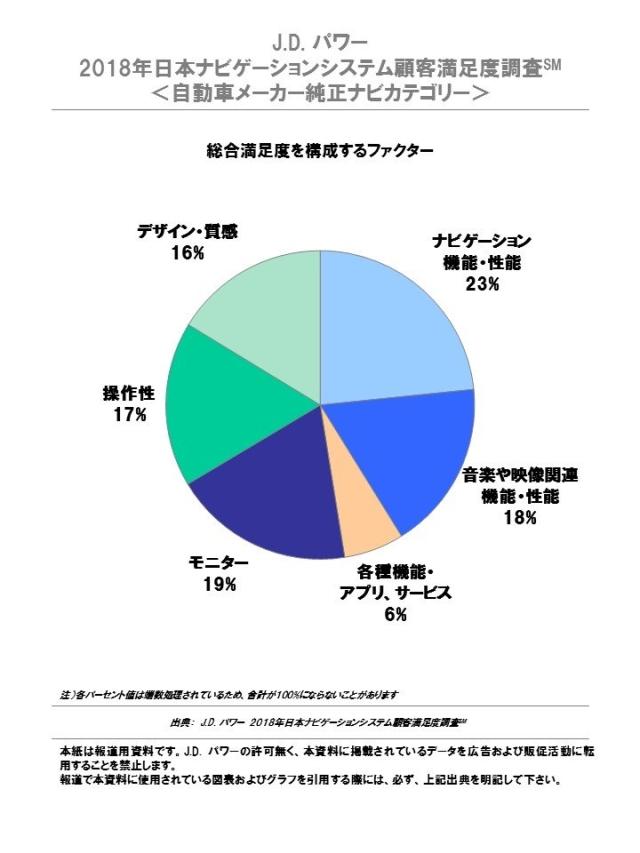J.D. パワー ジャパンは、2018年日本ナビゲーションシステム顧客満足度調査SM<自動車メーカー純正ナビカテゴリー>(Japan Navigation Systems Customer Satisfaction Index StudySM– OEM -)の結果を発表した。
◆顧客の関心を喚起するコネクト機能・サービスの開発が重要に◆
テレマティクスサービスやスマートフォン連携機能といったコネクト機能を備えたナビが年々増えている。
今年の調査結果では、テレマティクスサービスやスマートフォン連携機能の利用が顧客満足を高めることがわかった。業界平均の総合CSIの574ポイントに対して、テレマティクスサービスやスマートフォン連携機能利用者の総合CSIは+38もポイント上回る612ポイントだった。今後この分野への注力が顧客満足度向上へのカギとなるといえよう。
しかし、調査結果からはコネクト機能の普及に向けた課題も浮き彫りとなった。今回の調査では、68%のナビに、コネクト機能・サービスに必要な通信機器(車載通信機器DCM、スマートフォンなど)が接続されていることが確認できた。にもかかわらず、実際に通信を利用しテレマティクスサービスやスマートフォン連携機能を使っているのは全体の27%にとどまっており、依然としてハンズフリー電話やスマートフォンに保存された音楽データ再生だけの利用にとどまっているユーザーも多いことがわかった。
このような結果の背景には、顧客が利用したいと思うコネクト機能・サービスが不十分、もしくはコネクト機能のメリットが顧客に浸透していないといったことが考えられる。競合に対する優位性を確立するためにも、顧客の利用意向を喚起するコネクト機能・サービスの開発や市場へのアピールに引き続き取り組んでいくことが重要である。
◆音声操作機能の性能、操作性向上は必須◆
本調査では、ナビの音声操作状況についても聴取した。実際にナビを音声(音声認識/オペレーター)で操作していると回答した割合は全体の13%である。しかし、車載ナビを今後も利用したいとする顧客層では「最も利用したい操作方法は音声による操作」との回答は26%となっており、顧客の音声操作への関心、期待は高いといえる。
一方で、音声操作の普及においては、性能や操作性向上が必須の課題となっている。例えば、タッチパネルやコントロールスイッチなど従来の操作法に対する不満・不具合指摘は30%前後だが、音声操作機能については機能利用者の55%が不満・不具合を指摘している。また、音声操作利用者のうち32%は、「音声操作を試みる際、(性能の低さ等により)2回に1回以上の割合で音声操作をあきらめてしまう」と回答している。
音声操作への不満や不具合経験と顧客満足の相関は、タッチパネルやコントロールスイッチなど従来の操作方法よりも強く、顧客満足度向上には、機能を「問題なく使える」水準に改善することが重要である。
J.D. パワーのオートモーティブ部門 ディレクターである佐々木由至は次のようにコメントしている。
「ナビゲーションシステムはコネクト機能・サービスとの連携によって新しい価値を生み、車両の魅力そのものを大きく向上させようとしている。そのために必須となる通信環境は整いつつあり、機能やサービスのコンテンツ開発が各社の注力点となっている。その一方で高機能化するシステムをいかに容易に操作できるかも重要な課題である。特に音声操作機能の性能や操作性向上は喫緊の課題といえる。」
顧客満足度ランキングは下記の通りとなった。
【ラグジュリーブランド】(対象4ブランド)
第1位:レクサス(677ポイント)
全ファクターで業界平均以上評価。特に「ナビゲーション機能・性能」「操作性」で高評価。
第2位:BMW(602ポイント) 第3位:アウディ(601ポイント)
【量販ブランド】(対象9ブランド)
第1位:トヨタ(592ポイント)
「ナビゲーション機能・性能」「各種機能・アプリ、サービス」の評価が特に高く「音楽や映像関
連機能・性能」「操作性」でも対象ブランド中最高評価。
第2位:フォルクスワーゲン(583ポイント) 第3位:スバル(576ポイント)
《J.D. パワー 2018年日本ナビゲーションシステム顧客満足度調査概要》
自動車メーカー純正のナビゲーションシステム(標準装備・メーカーオプションナビ、及び純正仕様の販売店装着オプション)に関する顧客満足度を測定する調査。11回目となる本年調査は、デザイン要素やコネクトファクターの評価も含む調査内容に刷新して実施した。
■実施期間:2018年7月 ■調査方法:インターネット
■調査対象:2017年4月~2018年3月に新車を購入し純正ナビゲーションシステムを装着しているユーザー
■回答者数:ラグジュリーブランド:966サンプル、量販ブランド:6,234サンプル
満足度を構成するファクターは下記の通り。
「ナビゲーション機能・性能(23%)」「モニター(19%)」「音楽や映像関連機能・性能(18%)」「操作性(17%)」「デザイン・質感(16%)」「各種機能・アプリ、サービス(6%)」※()内は総合満足度への影響力
*J.D. パワーが調査結果を公表する調査は、J.D. パワーが第三者機関として自主企画実施したものです。
J.D. パワーでは、本調査以外にも、毎年複数の自動車関連調査の結果をリリースとして発表しています。


